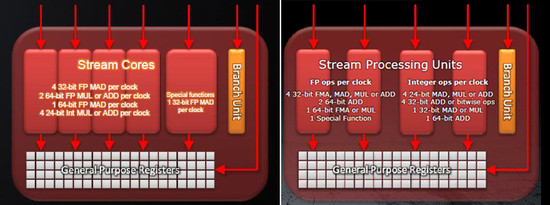Llano is just out, but the hottest news now is Trinity. the successor. Trinity is the first APU sporting Bulldozer. which means the end of K10.5, but also a whole new graphics processor. AMD has also presented Trinity in a working notebook.
At the launch of the new high-end GPU, Cayman, it introduced a whole new architecture with hoals of making the circuit even more energy efficient, smaller and easier to work with for software developers, e.g. for GPGPU applications. The result is actually fewer stream processing units per SIMD unit.
 VLIW-5 to VLIW-4 – a more efficient choice?
VLIW-5 to VLIW-4 – a more efficient choice?
It went from having four smaller cores and one bigger in each SPU (VLIW-5), to 4 “average” cores (VLIW-4). AMD said that its VLIW-5 was rarely used to full capacity and it talked about an average of 3.5 was used depending on the applikction, which made VLIW-4 the best way to go.
The new way makes it simpler to program for, which is very important with the growing use of GPGPU and it only occupies 90% of the surface VLIW-5 did. Each SIMD used 16 SPUs, so the number of processing units dropped from 80 to 64, while offering the same level of performance as before.
Instead of using 80 processing units called Radeon cores, in each SIMD, it went to 64 that was just as efficient. This resulted in Cayman having 1536 Radeon cores in 24 SIMDs while the precursor Cypress had 1600 Radeon cores in 20 SIMDs.
 During AMD Fusion Developer Summit where it presented the possibilities and helped developers with GPGPU programming, AMD said that Trinity will sport a VLIW-4 architecture just like Cayman and Rick Bergman presented a notebook with Trinity inside.
During AMD Fusion Developer Summit where it presented the possibilities and helped developers with GPGPU programming, AMD said that Trinity will sport a VLIW-4 architecture just like Cayman and Rick Bergman presented a notebook with Trinity inside.
We knew that Trinity will sport 4 Bulldozer cores, but it also looks like the graphics will be improved with the new APU that will be released in 2012 with GlobalFoundries 32nm SOI/HKMG process. Rick Bergman promised 50% better performanc ein Trinity over Llano, which means big changes are coming.
Source: PCPerspective, PCPerspective















